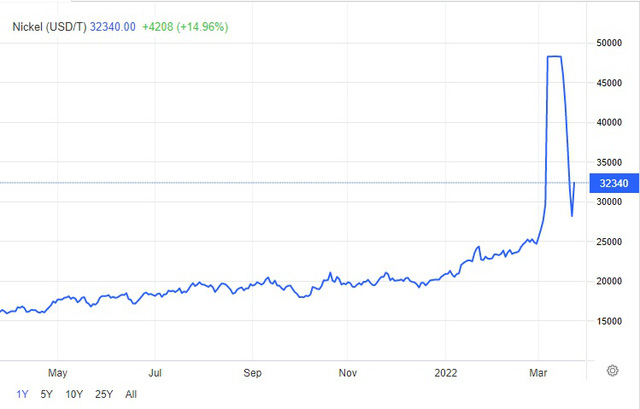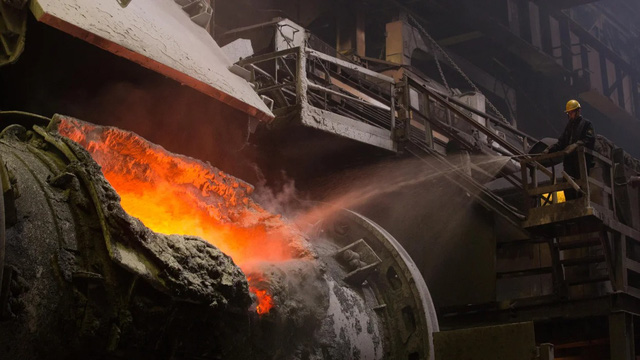Is the sharp increase in nickel prices ‘the end of the world’ for the electric vehicle industry?
According to the Global Electric Vehicle Market Statistics, global electric vehicle sales will reach 6.75 million units in 2021, a sharp increase of 108% compared to 2020. This output includes passenger cars, trucks and commercial vehicles. light commercial. The global share of electric vehicles (including pure electric vehicles and plug-in hybrids) in global light vehicle sales is 8.3% compared to 4.2% in 2020. Pure electric vehicles accounted for 71% of total EV sales, and 29% for plug-in hybrids.
Tesla leads the electric vehicle manufacturers rankings with 936,000 vehicles delivered, up 436,000 from 2020. Volkswagen Group is in second place and China’s BYD Auto has climbed four times to second place. 3. BYD delivered nearly 600,000 units in 2021, an increase of more than 400,000 units compared to 2020.
It can be seen that the electric vehicle market has strongly overcome the storms brought by the pandemic and is returning to the right development trajectory in 2021. In 2022, sales of electric cars are expected to increase. strong growth and reach 9.5 million units, if supply chain issues are resolved. This vibrant new vehicle market will also reach 30 million vehicles sold by 2028, before accounting for 48% of all passenger cars delivered to consumers by 2030.
However, the price of nickel metal, one of the important raw materials for the production of electric vehicle batteries, is entering a volatile “shake” period that makes the electric car market worry, whether the end date will be So is it coming to this manufacturing industry?
Nickel price fluctuations before the Russia-Ukraine conflict
The price of nickel, one of the important raw materials for the production of electric vehicle batteries, has increased sharply in recent times. In the trading session on March 8, the price of nickel traded at the threshold of USD 100,000/ton, a price twice as high as before. However, in the trading session on Monday, March 21, the price of this material fell sharply to $31,380/ton. The previous spike was due to the impact of Western sanctions against Russia.
This huge price volatility has caused the London Metal Exchange, which has a history of 145 years, to announce a temporary suspension of trading in Nickel until there is a price correction. That decision blew away $3.9 billion in trades.

Nickel price movements in the past 1 year. Data: Trading Economics.
However, the reality is that resources such as nickel and lithium have been depleted in nearly a decade. Analysts predict this shortfall will create a rush to produce renewable energy and other clean energy technologies, such as electric vehicle technology.
Ryan Petersen, CEO of global logistics platform Flexport, said: “Nickel prices are rising in short-term hyperbolic trends in this day and age, and I would also like to stress that nickel is an input material. important for electric vehicle batteries.”
Oil and gas prices are on the same page, if anyone now goes to the gas station to feel it. This creates a complex problem, which is that consumer interest and demand for electric vehicles will increase, but the price of metal for the production of electric vehicle batteries makes it difficult to meet demand.
Mr. Jonathan Crowder, founder of renewable energy-focused investment firm Intelis Capital, said: “The reality is that commodity production is all affected by geopolitical tensions. However, the impact is However, the increase in gas prices will have an immediate impact that is quickly felt by consumers themselves, but consumers seem to be paying attention to the price of electric vehicles and not the problems in battery metal supply chain”
Mr. Robert Mullin, general partner of natural resource investment consulting firm Marathon Resource Advisors, also made similar comments. In the past, they had to plan for costs and supply shortages in order to keep up with the electric car trend long before Russia entered Ukraine.
Investment Bank Morgan Stanley’s report published in early March indicated that an increase in the price of battery-producing metals could raise the cost of producing electric vehicles by about $1,000 a vehicle – not that high. at the present time, but may cause difficulties for car buyers.
The drastic price swings can be seen from the recent moves of Rivian, one of the strongest contenders to usurp Tesla’s top spot. The company initially said it would raise pre-order prices for two of its models in the face of supply chain constraints and inflation. However, Rivian later had to withdraw this decision in the face of media objections and company shareholders sued. Last week, Tesla also announced that it would increase the price of all its cars by 5-10%.
The supply chain needs to be changed
Mr. Mullin also added that to adapt, electric vehicle companies should look for a safe way for the supply chain to exploit their natural resources. For example, Tesla created some buffer against price fluctuations and supply constraints by signing an agreement with Minnesota-based nickel miner Talon Metals Corp.

Nickel mining has been difficult over the past decade. Photo: Getty Images.
However, the battery is not only made of nickel, it also includes other metals such as cobalt and lithium. Integrating system mining – like Tesla is doing – can be challenging for companies trying to create electric vehicles, but it’s the thing because it’s not just about adapting to the crisis. energy and raw materials crisis, but it also prevents future climate change.
Although it is impossible to swap nickel-based batteries with other types of batteries into the same car, a number of companies are working on making batteries that can be made from other metals to save energy. used in electric vehicles. Zinc and sodium ions are thought to be the most promising elements.
Integrating line production can come with other challenges, especially when companies all set stringent climate and environmental goals. Mining can be destructive to the environment and the industry also has potential for human rights abuses. By integrating mining operations, electric vehicle companies may face difficulties in meeting their environmental, climate, and anthropogenic goals.
Addressing those challenges and growing the mining industry to be equitable are essential in the future. Geopolitical tensions between Russia-Ukraine as well as volatility in the oil market show the limitation of fossil fuel resources. However, climate problems also require us to reduce carbon pollution, otherwise the consequences that it brings will be extremely heavy in the future.
In a 2018 Intergovernmental Panel on Climate Change report pointed out that the world needs to increase renewable energy to 470% by 2030, a staggering increase, while oil use, The current volatility in the nickel market shows the need for policies and support from the government to keep the prices of electric vehicles and renewable technology low enough to boost employment. more widely used.
However, addressing these issues and making the mining industry fairer is essential in the future. Russia’s war with Ukraine and volatility in the oil market suggest a need to limit fossil fuels, a move that will also weaken oil grades.
But the climate crisis also requires us to reduce our carbon pollution or endure a severely degraded future. In a 2018 report, the Intergovernmental Panel on Climate Change found that the world needed to increase renewable energy production by a staggering 470% by 2030, while oil use , gas and coal fell. The current strong volatility in the nickel market shows the need for policies and government support to keep the prices of EVs and renewable technologies low enough to drive wider adoption.
For his part, Mr. Crowder expressed he was not too worried. These supply chain problems will also fade away, and “We have to look at the overall price of batteries over the last 10 years, which has dropped massively.” “I don’t think this is the end of the world for electric vehicles.”
at Blogtuan.info – Source: Soha.vn – Read the original article here



